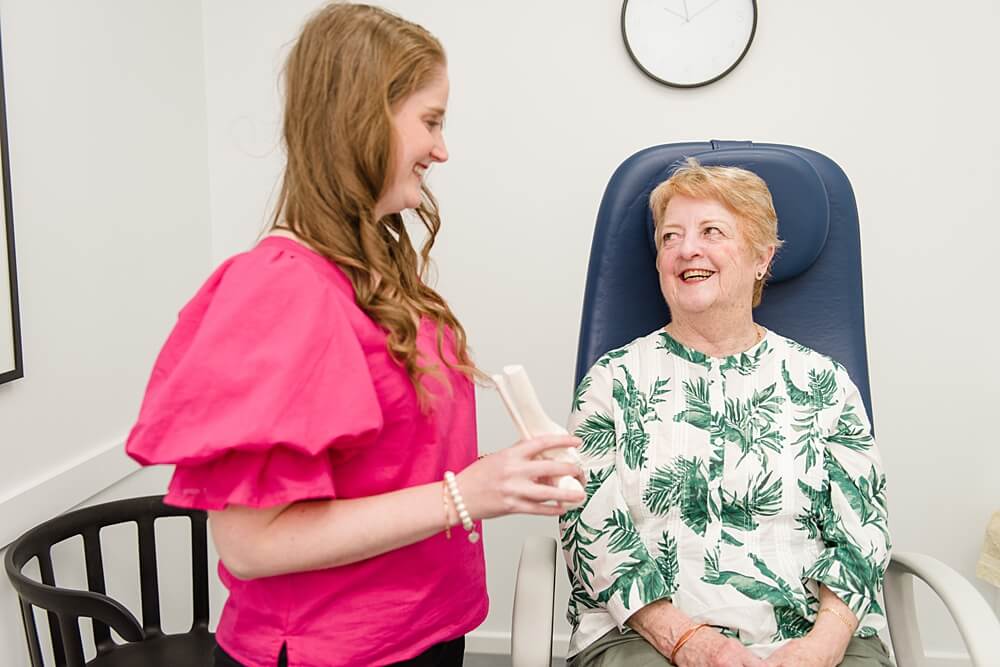Do you feel like there’s a constant discomfort, as if you’re walking on a stone? Are the balls of your feet burning and your toes going numb or tingling? These could be signs of Morton’s neuroma, a condition that involves inflammation and thickening of the tissue around the nerve between the third and fourth toes.
If you have these symptoms, it is important to seek expert podiatry care from a specially trained doctor who can diagnose and treat neuromas. Morton’s neuroma may cause pain, tenderness, or soreness in the foot. It is often diagnosed through palpation by an expert podiatrist or with diagnostic ultrasound to confirm compression of the nerve. Treatment options may include corticosteroid injections, NSAIDs (such as ibuprofen), biomechanical adjustments to footwear or orthotics, or even surgical intervention in more severe cases.
If left untreated, Morton’s neuroma can lead to permanent weakness and numbness in the affected area. It is important to remember that although some people live with this condition without seeking treatment for years, it does not mean they are not at risk for further complications. The latest research suggests that early intervention leads to better outcomes for patients. So if you find yourself experiencing any of these symptoms – such as numbness or tingling between your toes – don’t let discomfort linger any longer than necessary. Seek out expert podiatric services so that together we can address your concerns before they become more serious issues.
What is a neuroma?
A neuroma is a painful condition that affects the ball of your foot. The most common area is between your third and fourth toes, which takes the name “Morton’s Neuroma.” Neuromas can occur in any of the four intermetatarsal spaces of the foot.
Neuromas are a thickening of one of the nerves leading to your toes. The increase in size and, in most cases, associated swelling around the area can cause a sharp, burning pain in the ball of your foot. Your toes may also sting, burn or can feel numb as a result. Some people also report the sensation as ” walking on a stone.”
What causes neuromas?
Narrow or high-heeled shoes have been linked to neuroma development due to the position the foot is in, exposing the intermetatarsal tissues and the tightness that compresses the area. Flat shoes can also cause neuromas, particularly in people with a flexible and moveable forefoot, those that overpronate and when shoes are too short or narrow. Many people’s neuromas improve significantly by just modifying their footwear by wearing a wider-toe boxed shoe or reducing the heel height.
People with structural deformities in their feet, particularly bunions, are more predisposed to suffering from neuromas.
How do I know if I have a neuroma?
Neuromas can’t be seen like a lump. Instead, they are diagnosed through symptom reporting, a test where the practitioner squeezes and palpates areas of the forefoot, footwear assessment and can be confirmed on ultrasound or MRI.
It’s best not to ignore foot pain lasting longer than a few days.
Please make time to see one of our podiatrists at Highett Podiatry, as getting on to it sooner rather than later results in a quicker resolution.
An accurate assessment of your forefoot pain is required to establish whether you are suffering from a neuroma. At Highett Podiatry, we are trained and equipped to diagnose and treat your foot pain accurately and effectively.
What is the treatment for a Neuroma?
Your podiatrist will prescribe a treatment regime. This may include some or all of the following:
- Footwear modification and replacement of existing footwear
- Rest
- Soft tissue therapy to reduce the inflammatory process in the area.
- Therapeutic ultrasound
- Massage
- Strapping and padding
- Orthotics
- Ultrasound-guided steroid injection
- Our endorsed podiatrists on staff at Highett Podiatry are trained and qualified to prescribe and administer this in our clinic.
Combining these treatments, footwear advice, and modification will get you back on your feet, pain-free, in no time. In a small percentage of cases, a neuroma must be surgically removed. Highett Podiatry will advise and recommend this if you are one of the few who don’t respond to conservative treatment.

